Caballero B. (ed.) Encyclopaedia of Food Science, Food Technology and Nutrition. Ten-Volume Set
Подождите немного. Документ загружается.

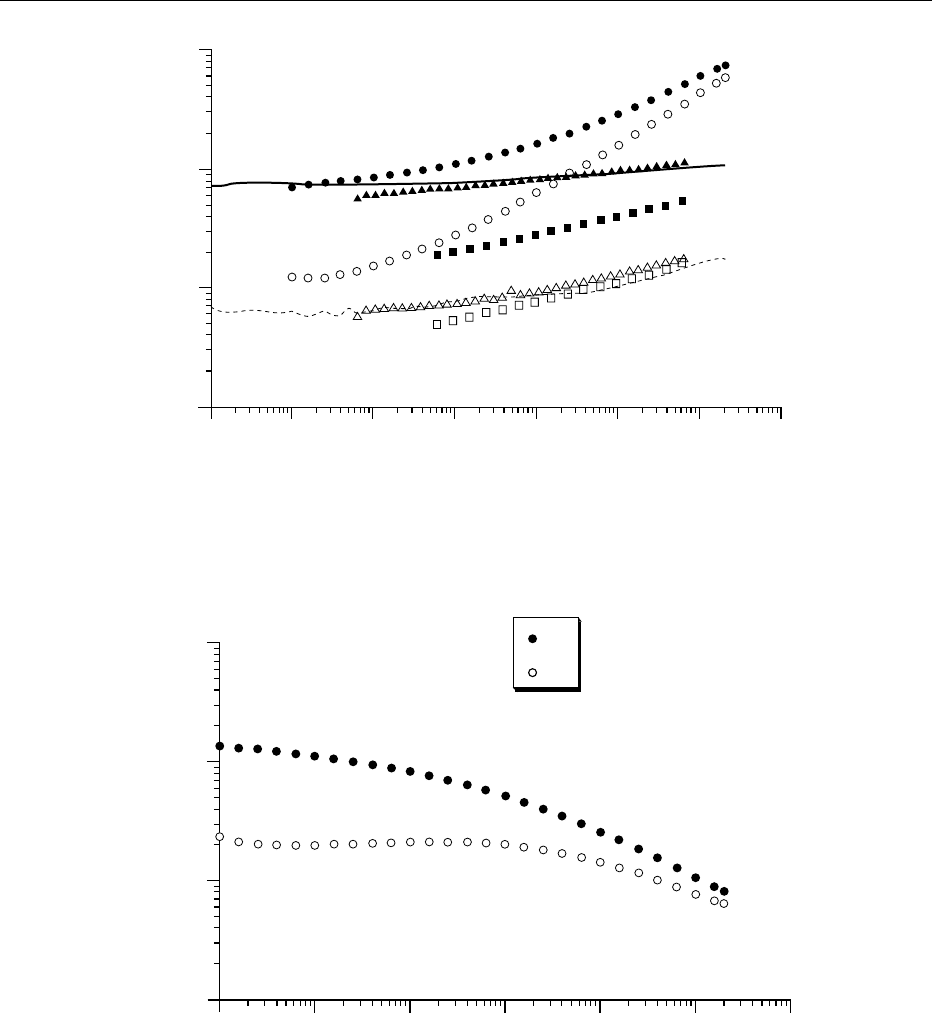
of the frequency window of dynamic measurements.
Plotting the data as J
0
(w), J
00
(w) is sometimes more
telling, as shown in Figure 14 for the same gluten as in
Figure 13; J
00
(w) displays a maximum at the right of
the frequency range, which at least allows location of
the upper end of the viscoelastic plateau on the time
scale and possibly opens the way to modeling this
region of the behavior.
0038Enlarging the time scale of observation is required
anyway for a full-scale rheological characterization.
In the case of classical polymer systems, the time–
temperature superposition principle, which means
that a change in the temperature of the system is
equivalent to a shift of the time scale of the behavior,
allows one to describe the viscoelastic behavior over a
very large frequency range from data obtained over
10
4
10
3
10
2
10
1
10
−4
10
−3
10
−2
10
−1
10
1
10
1
10
2
10
3
G',G" (Pa)
ω (rad s
−1
)
fig00 13 Figure 13 Mechanicalspectraobtainedat20
Cbydynamicmeasurementsonvarioussystemsofthecolloidalgeltype.Circles:
fullyhydratedglutenfromacommercialwheatcultivar.Triangles:heat-setgelofbovineserumalbumin(61mgml
1
,pH7,0.05moll
1
NaCl).Squares:experimentalyogurt.Lines:commercialmayonnaise.Filledsymbolsandsolidline:G
0
;emptysymbolsandinterrupted
line:G
00
.
10
−2
10
−3
10
−4
10
−5
10
−3
10
−2
10
−1
10
0
10
1
10
2
10
3
J',J" (m
2
N
−1
)
J'
J"
ω (rad s
−1
)
fig00 14 Figure 14 Mechanicalspectrum ofthesam eglutenasshownin Figure 13,butplottedasJ
0
andJ
00
versusangularfrequency.The
curve of J
00
shows a peak with a maximum close to o ¼ 0.16 rad s
1
; it bounds the viscoelastic plateau on the high-frequency side.
4976 RHEOLOGICAL PROPERTIES OF FOOD MATERIALS
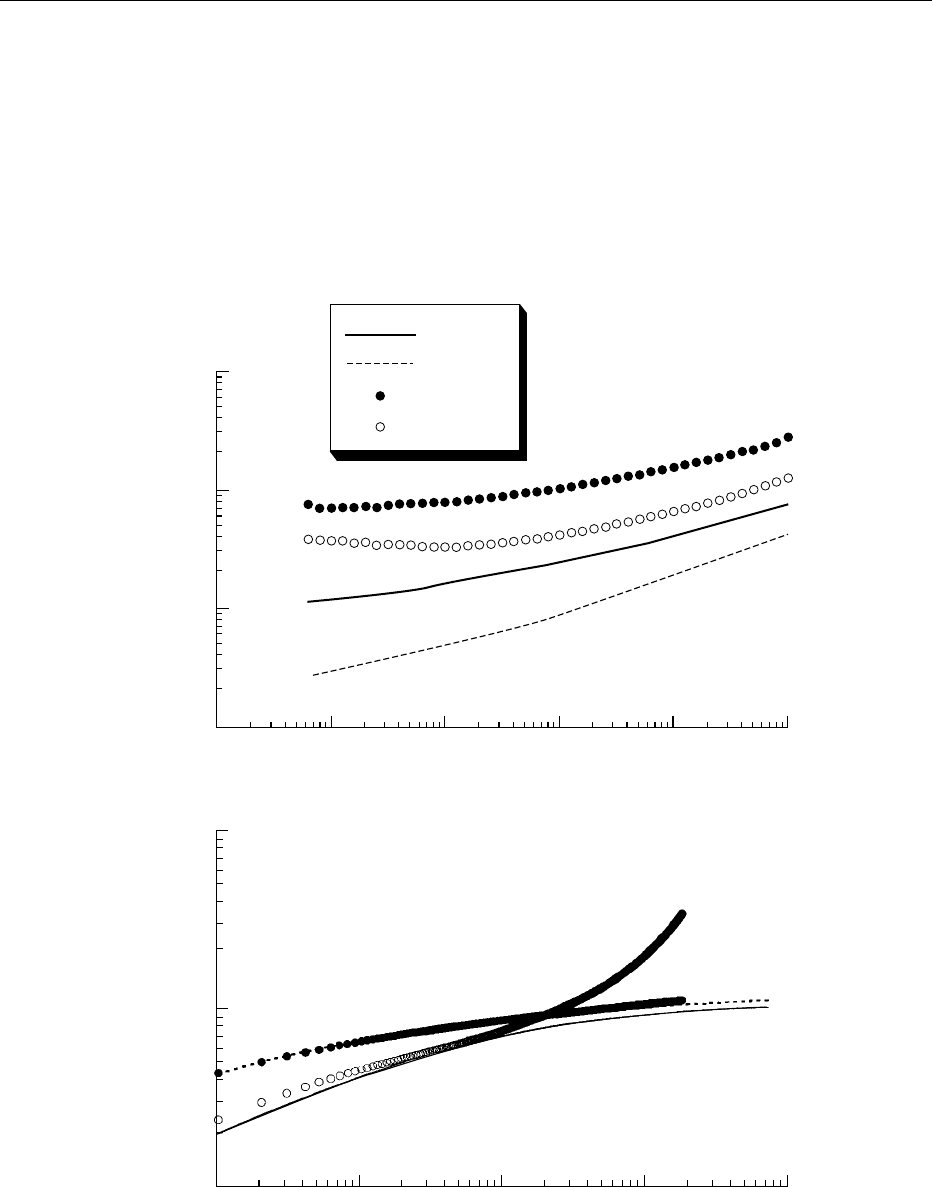
a restricted one at different temperatures. This
principle does not in general apply to food systems
since their elasticity is rarely entropy-driven; anyway,
the range of temperature which could be covered is
quite narrow because of the presence of liquid water.
One has then to combine dynamic measurements
with transient tests which permit one to extend the
observation window to longer times. Let us give a few
illustrations.
0039A gluten and a reconstituted dough are compared
in Figure 15. The mechanical spectra of a gluten and
of a ‘synthetic’ dough prepared by mixing it with
starch do not differ much on the 10
1
–10
2
rad s
1
range (Figure 15a). The moduli are somewhat larger
for dough, because starch granules act as a filler;
in fact, their presence also makes dough behavior
extremely nonlinear and the dynamic data are only
approximate. But when the materials are submitted
10
−3
(a)
10
2
10
3
10
4
10
5
10
−2
10
−1
10
0
10
1
10
2
G',G" (Pa)
G' gluten
G" gluten
G' dough
G" dough
ω (rad s
−1
)
10
−4
10
−3
10
−2
10
1
10
0
(b) 10
2
10
3
10
4
t (s)
J(t) (m
2
N
−1
)
fig0015 Figure 15 Viscoelastic behavior at 20
C of a reconstituted dough compared to that of the gluten used to prepare it. (a) Mechanical
spectra obtained by dynamic measurements under 0.05 strain amplitude over the 10
2
–10
2
rad s
1
frequency range. (b) Creep curves
under 350 Pa stress. Symbols: creep compliance J(t); lines: recoverable compliance J
r
(t). Filled symbols and dotted line, gluten; empty
symbols and solid line, dough.
RHEOLOGICAL PROPERTIES OF FOOD MATERIALS 4977
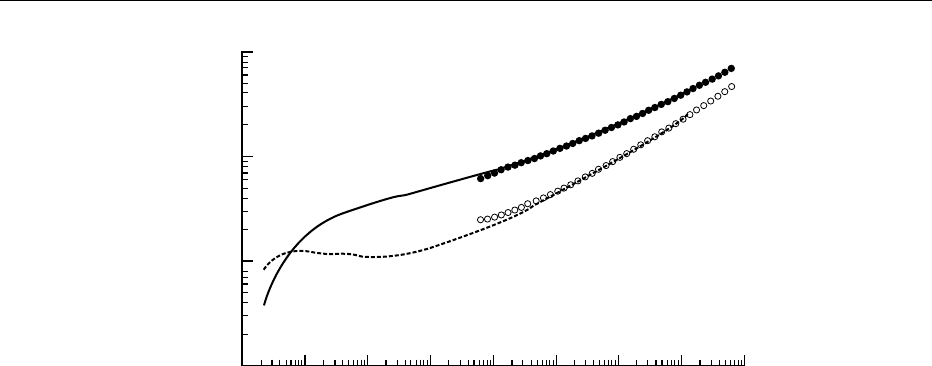
to a retardation test in the same conditions, the
difference becomes striking after 100-s creep (Figure
15b); analysis of the results shows that whereas J
e
is
about the same (* 10
3
m
2
N
1
), viscosity is much
smaller for dough (* 510
5
Pa s
1
) than for gluten
(10
7
Pa s
1
) at comparable shear rates (7 10
4
versus 2 10
4
s
1
).
0040 When the tests are performed within the linearity
range, it is possible to convert the data of relaxation
or retardation tests from the time to the frequency
domain. Combining the data of the retardation test
with those of dynamic measurements allowed us to
obtain the mechanical spectrum of a weak gluten
sample over about eight logarithmic frequency
decades (Figure 16). The viscoelastic plateau extends
over more than seven frequency logarithmic decades,
the terminal region of the spectrum being entered
only below *10
5
rad s
1
. Extended viscoelastic
plateaus result from strong interactions and multi-
level structures within the material. Such cases are
not exceptional in food systems and highlight the
fact that rheology is a matter of time.
See also: Colloids and Emulsions; Emulsifiers: Organic
Emulsifiers; Phosphates as Meat Emulsion Stabilizers;
Uses in Processed Foods; Gums: Properties of Individual
Gums; Nutritional Role of Guar Gum; Pectin: Properties
and Determination; Food Use; Protein: Sources of Food-
grade Protein; Quality; Heat Treatment for Food Proteins;
Starch: Structure, Properties, and Determination;
Sources and Processing; Functional Properties.
Further Reading
Axelos MAV, Renard D, Chevillard C and Lefebvre J (1999)
Viscoelastic properties of some biopolymer systems in
relation with their nano-structure. In: Stokke BT and
Elgsaeter A (eds) Wiley Polymer Group Review Series,
vol. 2, pp. 330–342. New York: Wiley.
Barnes HA (2000) A Handbook of Elementary Rheology.
Aberystwyth: Institute of Non-Newtonian Fluid
Mechanics.
Barnes HA, Hutton JF and Walters K (1989) An Introduc-
tion to Rheology. Amsterdam: Elsevier.
Ferry JD (1980) Viscoelastic Properties of Polymers, 3rd
edn. New York: Wiley.
Hill SE, Ledward DA and Mitchell JR (1998) Functional
Properties of Food Macromolecules, 2nd edn. Gaithers-
burg: Aspen.
Macosko CW (ed) (1994) Rheology. Principles, Measure-
ments, and Applications. New York: VCH.
Marin G (1988) Oscillatory rheometry. In: Collyer AA
and Clegg DW (eds) Rheological Measurement, pp.
297–343. London: Elsevier.
Powell RL (1988) Rotational viscometry. In: Collyer AA,
Clegg DW (eds) Rheological Measurement, pp.
247–296. London: Elsevier.
Rao MA and Steffe JF (eds) (1992) Viscoelastic Properties
of Foods. London: Elsevier.
Ross-Murphy SB (1994) Rheological methods. In: Ross--
Murphy SB (ed) Physical Techniques for the Study of
Food Biopolymers, pp. 343–392. London: Blackie.
Whorlow RW (1992) Rheological Techniques, 2nd edn.
Chichester: Ellis Horwood.
10
−6
10
1
10
2
10
3
10
4
10
−5
10
−4
10
−3
10
−2
ω (rad s
−1
)
G',G" (Pa)
10
−1
10
0
10
1
10
2
fig0016 Figure 16 An example of a combination of the retardation test with dynamic measurements in order to describe the viscoelastic
behavior of a material over a large time scale. The material is a fully hydrated gluten from an experimental wheat line. Mesurements
were performed within the linearity range at 20
C. The data from the recovery part of the retardation test were converted from the time
to the frequency domain using an approximation method. Symbols: dynamic measurements: filled symbols, G
0
; empty symbols, G
00
.
Lines: recovery data: solid line, G
0
, dotted line, G
00
.
4978 RHEOLOGICAL PROPERTIES OF FOOD MATERIALS

RHEOLOGY OF LIQUIDS
A E Bell, University of Reading, Whiteknights,
Reading, UK
This article is reproduced from Encyclopaedia of Food Science,
Food Technology and Nutrition, Copyright 1993, Academic Press.
Background
0001 Food materials are multiphase, multicomponent
systems whose rheological characteristics frequently
present process engineers with difficult handling and
pumping problems.
0002 The food industry has, almost since its incep-
tion, been concerned with the physical properties of
its products, in terms of both their processing and
their eating characteristics. Consequently, consider-
able care must be taken in designing plant and process
if the texture, consistency, and quality of the final
product are not to be compromised. The selection
of appropriate pumps and conveying and mixing
systems is especially germane to food materials that
may be shear-dependent and/or abrasive in nature.
(See Rheological Properties of Food Materials.)
0003 Although it is a relatively easy matter to describe
mathematically the flow behavior of ‘simple’ liquids,
food solid/liquid mixtures present unique problems in
describing their flow behavior.
Liquid Behavior
0004 When assessing the behavior of a liquid system, it is
usual to investigate the stresses generated when the
sample is sheared, that is to say, the force per unit area
produced when the ‘layers’ of liquid move over each
other in the direction of flow. This gives rise to the
classical definition of a shear viscosity (Figure 1):
0005 Shear rate, g ¼V/h (s
1
)
0006 Shear stress, s ¼F/A (Pa)
0007 Shear viscosity, Z ¼s/g (Pa s),
where V is the velocity, F is the force, and A is the area
over which it acts.
0008 The range of shear rates observed in the food indus-
tries is vast, from values as low as 10
2
s
1
, for the
self-leveling of a liquid due to surface tension, to
10
6
s
1
seen in the spray drying of slurries. (The
chewing and swallowing of foods generate shear
values of about 10
1
–10
2
s
1
.) This presents us with
considerable difficulties with regard to most food
systems, as very few behave in an ideal or Newtonian
manner, with the shear stress proportional to the
shear rate over all of the possible shear rate values.
0009Since viscosity is essentially related to shear rate
and stress, it is possible to operate a viscometer in
one or two modes: (1) by applying a rotation and
measuring the torque generated (controlled stain),
or (2) by applying a fixed torque and measuring the
speed generated (controlled stress). These two
methods have their advantages and disadvantages;
for example, the controlled-strain instruments are
relatively cheap, robust, and well understood but
usually have a limited shear range (1–1000 s
1
). Con-
trolled-stress instruments, however, have large shear
rate ranges and can carry out other forms of testing
(creep, oscillatory, etc.) but do tend to be somewhat
expensive.
Working Liquids
0010When we work a liquid system, we apply energy to it.
This ‘force’ has a number of characteristics that
we can define: (1) the area over which it is applied,
(2) the distance over which it acts, and (3) the rate at
which it is applied. We may then define the stresses
involved (force/area) and the strains produced (rela-
tive deformation). If a more complex analysis is re-
quired, these forces may be resolved further into three
components, the tensile or normal forces, perpendicu-
lar to the plane of the applied force, and two shear or
tangential forces parallel to it.
0011The strain (distance moved) when processing or
measuring a sample has a considerable effect on its
mechanical behavior/flow properties. If a sample is
moved such that its molecular domains or structural
elements no longer interact/overlap, the network may
become ‘overloaded’ and ultimately break down
(Figure 2). For example, a sample of an emulsion
A
h
V.F.
fig0001Figure 1 Classical shear viscosity. Reproduced from Rheology
of Liquids, Encyclopaedia of Food Science, Food Technology and Nu-
trition, Macrae R, Robinson RK and Sadler MJ (eds), 1993, Aca-
demic Press.
RHEOLOGY OF LIQUIDS 4979
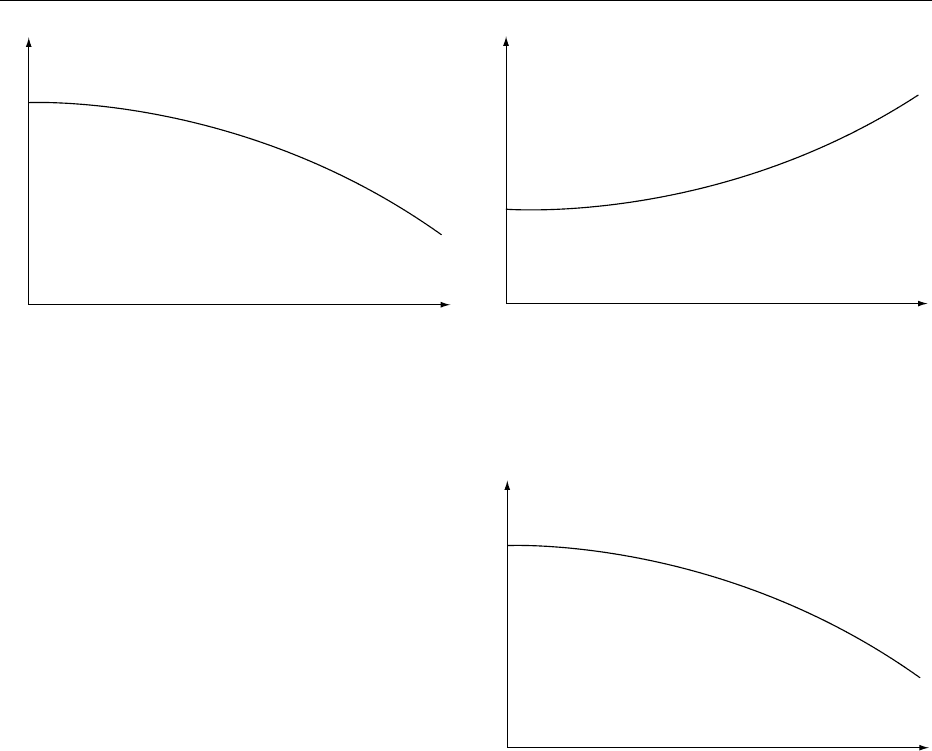
such as mayonnaise, which is stabilized by electro-
static or steric means, may have a very low value of
‘critical strain,’ after which structural damage to the
emulsion will occur, and it is very important that
testing and processing be carried out in such a
way so as not to exceed this point. (See Colloids and
Emulsions.)
0012 While, in general, increasing the strain tends to
reduce interactions, increasing the shear rate may
give rise to either increases or decreases in the appar-
ent degrees of interaction. If we consider the effect of
increasing the shear rate on entangled long-chain
polymer systems (e.g., a long-chain polysaccharide),
at zero shear rate, these chains will be entangled by
Brownian motion and will have a degree of inter-
action based on physical constraints. On moving
one of the chains slowly with respect to the others,
very little resistance would be encountered, as the
molecules would have sufficient time to allow any
rearrangements needed to take place. However, if
the same process were carried out at a higher rate,
the entanglement would have insufficient time for
rearrangement and would resist such movement.
This would produce a material that appeared to
increase its degree of interaction at higher shear
rates. Such a system may become unworkable if, for
example, one attempted to pump it too quickly
(Figure 3). (See Carbohydrates: Classification and
Properties.)
0013 However, if a system were stabilized by, for
example, some form of hydrogen bonding, an in-
crease in shear rate might reduce the effectiveness of
the interactions. This would lead to a fall in the
apparent consistency (Figure 4).
0014 The two parameters, strain and rate, when com-
bined give an overall picture of the behavior of the
liquid. This rheological ‘plane’ may be very flat (basic
Newtonian behavior) or, more commonly, steeply
curving (nonideal behavior). The consequences of
not having assessed the physical characteristics over
a suitable testing regime may prove disastrous in
terms of predicting processing behavior.
Behavior as a Function of Time
0015In the description of the different types of non-
Newtonian behavior, it was implied that, although
the viscosity of a fluid might vary with shear rate, it
was independent of the length of time that the shear
rate was applied, and also that replicate determin-
ations at the same shear rate would always produce
the same viscosity. This must be considered as the
ideal situation, since most non-Newtonian food ma-
terials are colloidal in nature, and as such, the flowing
Rate
'Consistency'
fig0003Figure 3 Increasing interaction with shear rate. Reproduced
from Rheology of Liquids, Encyclopaedia of Food Science, Food
Technology and Nutrition, Macrae R, Robinson RK and Sadler MJ
(eds), 1993, Academic Press.
Strain
'Consistency'
fig0002 Figure 2 Effect of increasing strain. Reproduced from Rhe-
ology of Liquids, Encyclopaedia of Food Science, Food Technology
and Nutrition, Macrae R, Robinson RK and Sadler MJ (eds),
1993, Academic Press.
Rate
'Consistency'
fig0004Figure 4 Decreasing interaction with shear rate. Reproduced
from Rheology of Liquids, Encyclopaedia of Food Science, Food
Technology and Nutrition, Macrae R, Robinson RK and Sadler MJ
(eds), 1993, Academic Press.
4980 RHEOLOGY OF LIQUIDS
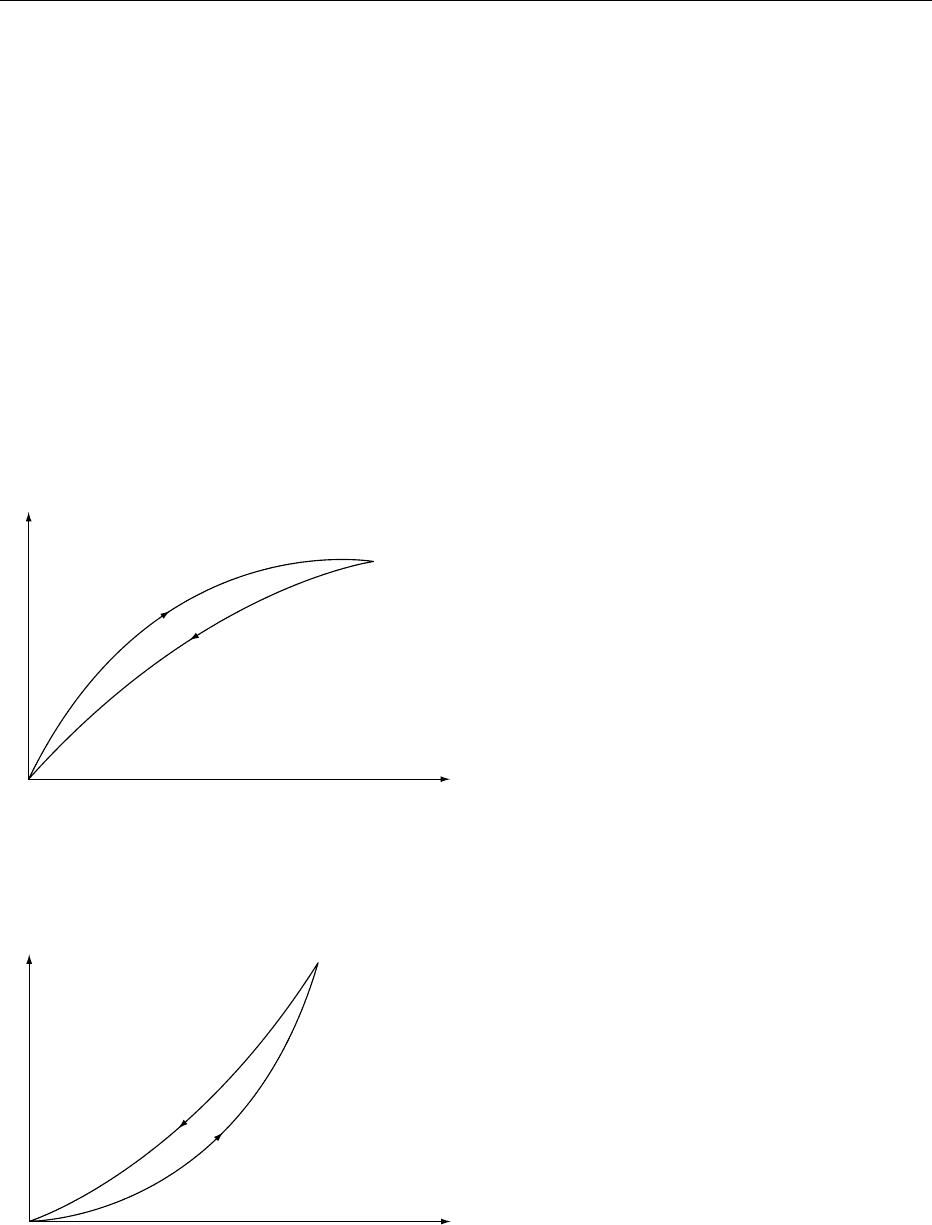
elements, whether particles or macromolecules, may
not adapt immediately to the new conditions. There-
fore, when such a material is subjected to a particular
shear rate, the shear stress and, consequently, the
viscosity will decrease with time. Furthermore, once
the shear stress has been removed, even if the struc-
ture that has been broken down is reversible, it may
not return to its original structure (rheological ground
state) instantly. The common feature of all these
materials is that, if they are subjected to a gradually
increasing shear rate followed immediately by a shear
rate decreasing to zero, the downcurve will be dis-
placed with regard to the upcurve, and the rheogram
will exhibit a hysteresis loop.
0016 In the case of plastic and pseudoplastic materials,
the downcurve will be displaced to below the upcurve
(Figure 5), whereas for dilatant substances, the re-
verse will be true (Figure 6).
0017The presence of the hysteresis loop indicates that a
‘breakdown’ in structure has occurred, and the area
with the loop may be used as an index of the degree of
‘breakdown.’
0018The term that is used to describe one such type of
behavior is thixotropy, which means ‘to change by
touch.’ Strictly, this term should be applied only to an
isothermal sol–gel transformation. It has, however,
become common to describe as thixotropic any
material that exhibits a reversible time-dependent
decrease in apparent viscosity. Thixotropic systems
are usually composed of asymmetric particles or
macromolecules that are capable of interacting by
numerous secondary bonds to produce a loose three-
dimensional structure, so that the material is gel-like
when unsheared. The energy that is imparted during
shearing disrupts these bonds so that the flowing
elements become aligned, and the viscosity falls,
since a gel–sol transformation has occurred. When
the shear stress is eventually removed, the structure
will tend to reform, although the process is not im-
mediate and will increase with time as the molecules
return to the original state under the influence of
Brownian motion. Furthermore, the time taken for
recovery, which can vary from minutes to days
depending upon the system, will be directly related
to the length of time that the material was subjected to
the shear stress, since this will affect the degree of
breakdown.
0019In some cases, the structure that has been destroyed
is never recovered, no matter how long the system is
left. Repeat determinations of the flow curve will then
only produce the downcurve that was obtained in the
experiment that resulted in the material’s destruction.
Such behavior should be referred to as ‘shear destruc-
tion’ rather than thixotropy, which, as will be appre-
ciated from above, is a misnomer.
0020An example of such behavior are the gels produced
by high-molecular-weight polysaccharides, which are
stabilized by large numbers of secondary bonds. Such
systems undergo extensive reorganization during
shearing such that the three-dimensional structure is
reduced: the gel-like nature of the original is then
never recovered.
0021The occurrence of such complex behavior creates
problems in quantitative classification because not
only will the apparent viscosity change with shear
rate, but there will be two ‘viscosities’ that can be
calculated for any given shear rate (i.e., from the
upcurve and the downcurve). It is usual to attempt
to calculate one viscosity for the upcurve and another
for the downcurve. This must assume, of course, that
each of the curves achieves linearity over some of its
length; otherwise, a defined shear rate must be used:
only the former situation is truly satisfactory. Each of
Rate
Stress
fig0006 Figure 6 Dilatant behavior. Reproduced from Rheology of
Liquids, Encyclopaedia of Food Science, Food Technology and Nutri-
tion, Macrae R, Robinson RK and Sadler MJ (eds), 1993, Aca-
demic Press.
Rate
Stress
fig0005 Figure 5 Plastic/pseudoplastic behavior. Reproduced from
Rheology of Liquids, Encyclopaedia of Food Science, Food Technol-
ogy and Nutrition, Macrae R, Robinson RK and Sadler MJ (eds),
1993, Academic Press.
RHEOLOGY OF LIQUIDS 4981

the lines used to derive the viscosity may be extrapo-
lated to the shear stress axis to give an associated
yield value. However, only that derived from the
upcurve has any significance, since that derived
from the downcurve will relate to the broken-down
system. Consequently, the most useful index of thix-
otropy can be obtained by integration of the area
contained within the loop. Of course, this does not
take into account the shape of the up- and down-
curves, and consequently, two materials may produce
loops of similar area but have completely different
shapes representing totally different flow behaviors.
In order to prevent confusion, it is best to adopt a
method whereby an estimate of area is accompanied
by yield value(s). This is of particular importance
with flow curves that exhibit complex upcurves.
0022 This situation is typical of the type of loop obtained
with, for example, some samples of white soft paraf-
fin, where the upcurve exhibits a number of bulges
(Figure 7). Those at a lower shear rate are thought
to be associated with the initial loss of the three-
dimensional structure, while the smoother deviations
occurring at the higher shear rates are associated with
molecular reorientation. Such behavior is common in
food and pharmaceutical systems and is one of the
major causes of difficulties in their evaluation.
0023 With such a wide range of rheological behavior, it
is extremely important to carry out measurements
that will produce meaningful results. It is crucial,
therefore, not to use a determination of viscosity at
one shear rate (such as would be acceptable for a
Newtonian fluid), since it could lead to completely
erroneous comparative results.
0024Figure 8 shows rheograms that are an example of
four different types of flow behavior, all of which
intersect at point A, which is equivalent to a shear
rate of 100 s
1
. Therefore, if a measurement were
made at this one shear rate, all four materials would
be shown to have the same viscosity, although they all
possess different properties and behavior. Single-point
determinations are probably an extreme example but
are used to emphasize the importance of properly
designed experiments.
0025It should be noted that while more complex rheo-
logical measurements may give rise to parameters
other than viscosity (for example, the storage and
loss moduli), the arguments given here still apply,
and time and shear dependence remain major prob-
lems when measuring changing food systems.
See also: Carbohydrates: Classification and Properties;
Colloids and Emulsions; Rheological Properties of
Food Materials
Further Reading
Ferry JD (1980) Viscoelastic Properties of Polymers, 3rd
edn. New York: Wiley.
Larson RG (1998) The Structure and Rheology of Complex
Fluids, 688 pp. Oxford, UK: Oxford Press.
Lewis MJ (1987) The Physical Properties of Foods and Food
Processing Systems. Chichester, UK: Ellis Horwood.
Rate
A
Stress
fig0008Figure 8 Convergence of flow behavior at a single rate. Repro-
duced from Rheology of Liquids, Encyclopaedia of Food Science,
Food Technology and Nutrition, Macrae R, Robinson RK and Sadler
MJ (eds), 1993, Academic Press.
Rate
Stress
fig0007 Figure 7 Complex flow behavior. Reproduced from Rheology
of Liquids, Encyclopaedia of Food Science, Food Technology and Nu-
trition, Macrae R, Robinson RK and Sadler MJ (eds), 1993, Aca-
demic Press.
4982 RHEOLOGY OF LIQUIDS
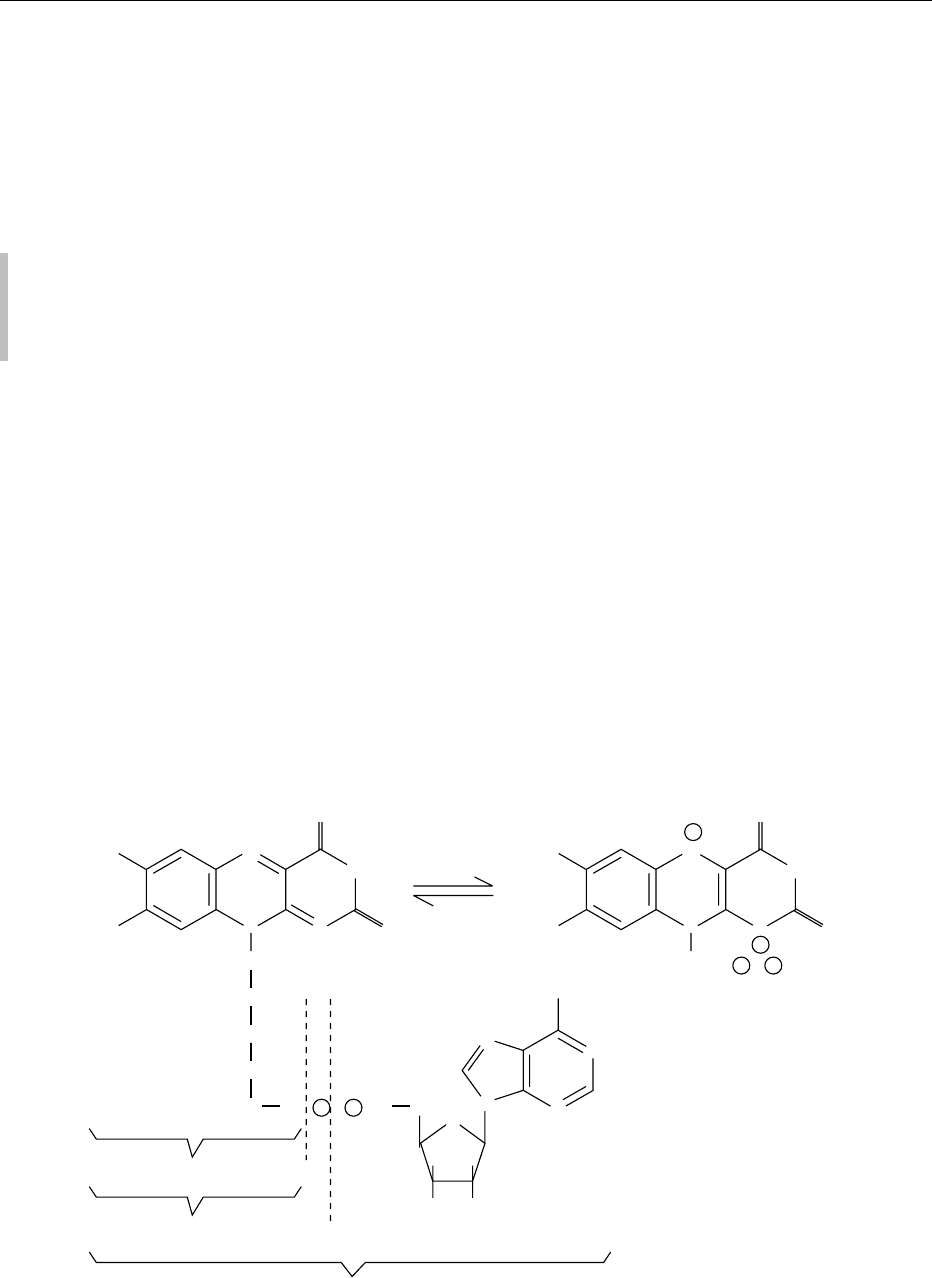
RIBOFLAVIN
Contents
Properties and Determination
Physiology
Properties and Determination
R Bitsch, Friedrich-Schiller-University, Jena,
Germany
Copyright 2003, Elsevier Science Ltd. All Rights Reserved.
Physicochemical Characteristics
0001 Riboflavin, the name prescribed for vitamin B
2
by
the International Union of Pure and Applied Chemis-
try – International Union of Biochemistry, is the bio-
logically active component of the prosthetic group of
flavoproteins. Older designations are lactoflavin,
ovo-, or uroflavin, which originated from the first
isolation. It comprises a tricyclic, nitrogen-containing
ring-system, chemically defined as a substituted iso-
alloxazine with a ribitol side-chain at N
10
. With the
systematical nomenclature, the molecule is named
7,8-dimethyl-10-(1-d-ribityl)-benzo[g]pteridin-2,4-
dion. The empiric formula is given as C
17
H
20
N
4
O
6
with a molecular weight of 376.36 (Figure 1). The
substance is a yellow to orange–yellow powder and
crystallizes in sharp, optically active needles, melting
under decomposition at 275–282
C. The optical ro-
tation is ½a
25
D
¼112 to 122
C at a concentration
of 50 mg in 10 ml of 0.02 N alcoholic NaOH). Ribo-
flavin is sparingly soluble in water with a yellow–
green fluorescence, very sparingly soluble in ethanol,
and insoluble in other organic solvents. It is readily
soluble in dilute alkali, but rapidly deteriorated, being
accelerated by light. In neutral or acid solutions, it is
more stable, even against heat and atmospheric
oxygen. Nevertheless, all operations with riboflavin
solutions should be handled in the dark or in red light.
The light sensitivity of the flavins also has conse-
quences for the stability of vitamin B
2
containing
foods. In milk stored in day light, the riboflavin
content decreases by more than 80% within hours.
Processing losses in foods are given with approxi-
mately 20%.
H
3
C
H
3
C
N
N
CH
2
CH
2
NH
2
HCOH
HCOH
HCOH
H
2
C
N
NH
O
O
H
3
C
H
3
C
N
N
N
O
O
O ~ O
P
H
H
~
P
~
Ribit ~ Adenin
P
~
P
~
Riboflavin
FMN (H
2
)
FAD (H
2
)
N
N
N
N
OH OH
O
+2[H]
−2[H]
NH
fig0001 Figure 1 Riboflavin and its coenzyme forms.
RIBOFLAVIN/Properties and Determination 4983
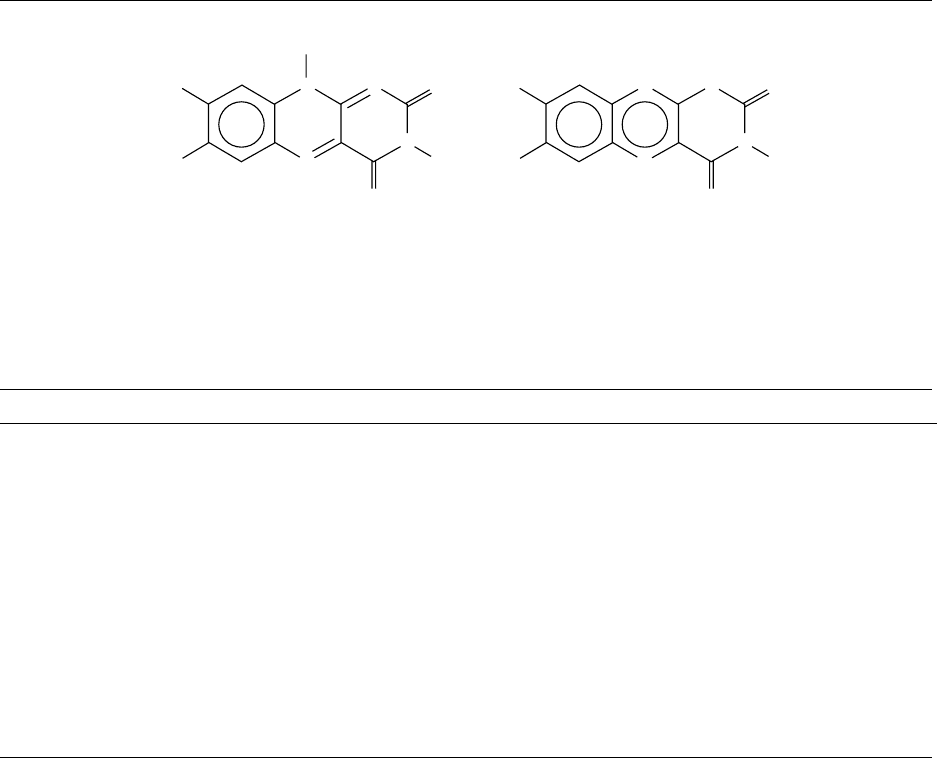
0002 Light exposure of alkaline solutions decomposes
riboflavin to lumiflavin (7.8.10-trimethylisoalloxa-
zine), and in neutral or acidic solutions, the blue
fluorescent lumichrome (7.8-dimelthylalloxazine) is
formed (Figure 2 and Table 1). Riboflavin is found
in free form only in the retina of the eye, whey, and
urine. In other biological systems and tissues, the
predominant forms are flavin mononucleotide
(FMN) or riboflavinphosphate and flavin adenine
dinucleotide (FAD). Free riboflavin and FMN-mono-
sodium salt are the most important commercial prod-
ucts. FMN and FAD are effective as coenzymes or
prosthetic groups in more than 100 enzymes in the
plant and animal kingdoms. The accepted designa-
tion for both compounds is incorrect, because FMN is
not truly a nucleotide and FAD is not a dinucleotide.
The designations arose from the discovery of ribofla-
vin, and have been adopted ever since. Pure riboflavin
was first isolated from yeast, egg white, and whey
in 1933 (by Kuhn and Wagner-Jauregg). Simultan-
eously, the so-called ‘yellow coenzymes’ were
discovered (by Warburg and Christian) in yeast and
could be identified as FMN. FMN is considerably
more soluble in water than riboflavin. Its solubility
in organic solvents and its stability against heat and
light exposure are comparable with that of riboflavin.
The flavoproteins FMN and FAD belong to the en-
zymatic class of oxidoreductases. The conjugated
structure of the pteridine moiety of the basic molecule
determines its coloring and light absorbance in the
UV and visible spectrum. Absorbance maxima for the
flavins are listed in Table 1. Likewise, catalytic hydro-
gen transfer in the flavin enzymes takes place at both
conjugated of bound N
1
and N
5
atoms of the isoal-
loxazin molecule. The oxidized form of the flavopro-
teins, the flavoquinone, is thereby reversibly reduced
to the colorless flavohydroquinone or leucobase (see
Figure 1). The absorbance is lost, because double
bonds are dissolved. As an intermediate product
during this reaction, a radical semiquinone is formed.
During the redox process, the flavin molecule changes
its conformation, which is planar in the oxidized state
H
3
C
H
3
C
N
N
N
N
CH
3
O
O
H
H
3
C
H
3
C
N
N
N
N
O
O
H
Lumiflavin
(alkaline solution)
Lumichrome
(acidic solution)
fig0002 Figure 2 Photolysis products of riboflavin (lumiflavin and lumichrome).
tbl0001 Table 1 Physicochemical data of flavines
a
Property Riboflavin Riboflavin- 5 -phosphate-Na (FMN-Na) Flavin adenine dinuclectide-Na
2
(FAD-Na
2
)
Molecular weight 376.36 478.34 829.6
Melting point 278–282
C (decomp.) 280–290
C (decomp.)
Solubility Readily soluble in dilute alkalis
(decomp.)
Soluble in water at pH 7
(30 g l
1
,25
C)
Soluble in water
Sparingly soluble in water
(70–100 mg l
1
,27
C)
Very sparingly soluble in ethanol
(45 mg l
1
,27
C)
Very sparingly soluble in ethanol
Insoluble in acetone, chloroform, ether, benzene
Absorbance (UV/vis) 223, 267, 374, 444 nm (0.1 N–HCI)
Fluorescence Yellow–green fluorescence of aqueous solutions at pH 6–7
(ex. 444 nm, em. 530–565 nm)
ex. 400–500 nm, em. 530 nm
Stability In neutral and acidic medium relatively stable against heat and oxygen. Rapid photolysis by UV- and visible
light to blue fluorescent lumichrome (acidic and neutral solutions) or yellow–green fluorescent lumiflavin
(alkaline solutions). After reduction by dithionite, Zn–HCI, sodium hydrosulfite, etc. reversible conversion
to leucoflavin (dihydroflavin)
a
According to The Merck Index, 11th edn. Rahway NJ: Merck & Co. and modified from Eitenmiller RR and Landen WO, Jr. (1999) Vitamin Analysis for the
Health and Food Sciences, pp. 229–337. Boca Raton, FL: CRC Press.
4984 RIBOFLAVIN/Properties and Determination

and folded in a butterfly configuration in the reduced
state.
0003 The characteristic yellow–green fluorescence of
riboflavin and FMN in aqueous solutions exhibits
maximal intensity at pH 6–7. The fluorescence of
FAD is about 10–20% of that of riboflavin with the
same spectral distribution but exhibiting a maximal
intensity at pH 3. The fluorescence of flavins is
quenched when bound to proteins. The irradiation
products of the flavins also fluoresce, and their spec-
trum is shifted to the blue (lumichrome) or green
(lumiflavin) spectral range. Riboflavin can be quanti-
fied by conversion to lumiflavin and by measuring its
fluorescence intensity in chloroformic solutions with
exitation (ex.) at 270 nm, and emission (em.) at
418 nm.
Methods of Determination
0004 Initially, direct fluorimetry of the intact flavins or
after hydrolysis to FMN or free riboflavin have been
most frequently used for quantitation of vitamin B
2
active components. Alternatively, the lumiflavin
method based upon the conversion of the chloro-
form-insoluble riboflavin into chloroform-soluble
lumiflavin after photodegradation in alkaline solu-
tion can be used, despite a transformation rate of
only 60–70%. Currently, microbiological assays and
HPLC procedures with an enhanced sensitivity are
widely used (see also Table 2).
0005 In principle, riboflavin is extracted from dry mater-
ials by autoclaving in 0.1 N HCl for 30 min or in a
water bath for 1–2 h. By using acid extraction, flavins
are released from their protein binding, and FAD and
FMN are converted to free riboflavin. In protein-rich
materials, acidic extraction may be followed by en-
zymatic hydrolysis for complete liberation of flavins.
It is important to carry out all operations relating to
the extraction and quantitation of flavins and ribofla-
vin under dim light and in brown or dark vessels.
Direct Fluorimetry
0006Direct measurement of the native fluorescence of
riboflavin may be applicable for pharmaceutical
preparations or food samples with a relatively high
vitamin content. After acid extraction, any remaining
proteins are removed by precipitation at pH 4.5.
Interfering substances are subsequently oxidized
with potassium permanganate and excess oxidant
destroyed with hydrogen peroxide or sodium bisul-
fite. The fluorescence of the clear sample solution,
commonly spiked with riboflavin as an internal
standard, is registered by difference measurement
before and after reduction of riboflavin with sodium
bisulfite to the leuco form for correction by unspecific
fluorescence (ex. ¼440 nm; em. ¼565 nm).
0007The detection limit of this method is about 0.1 mg
of riboflavin per gram of sample. The direct fluori-
metry of flavins had been adopted by the US Pharma-
copoeia for the riboflavin analysis in tablets and
injections, and by the AOAC for the riboflavin deter-
mination in foods, as in milk-based formulas, for
example.
Lumiflavin Method
0008In this method, riboflavin is photodegraded in alka-
line solution at pH 10–12 to the stronger fluorescent
lumiflavin (ex. ¼270 nm; em. ¼418 nm). This reac-
tion is specific for riboflavin, since other flavins inter-
fering with riboflavin fluorescence are not converted
into lumiflavin. Lumiflavin is separated from ribofla-
vin and other fluorescent substances by extraction
with chloroform. The transformation into lumiflavin
is not quantitative and ranges between 60 and 70%.
Reliable results can be obtained only by comparison
tbl0002 Table 2 Methods of riboflavin determination
Method Principles Specials Detectionlimits
Direct fluorimetry Fluorescence measurement of riboflavin at
440 (ex.)/565 (em.) nm
Conversion of FAD and
FMN to riboflavin by
acidic hydrolysis
0.1 mgB
2
per gram of sample
Lumiflavin method Fluorescence measurement after irradiation
at pH 10–12 (ex. 270, em. 418 nm)
Lumiflavin is separated by
chloroform extraction
0.02 ng of B
2
Microbiological assay Turbidimetric measurement of bacterial
growth response dependent on the
B
2
content
Interference of growth
response with nutrients/
food components
0.1–0.5 ng of B
2
HPLC analysis Separation of flavins on RP-C
18
materials
with aqueous/organic solvents and
fluorimetric/UV detection
Differentiated analysis of
flavins, combined
analysis with other
B-vitamins
0.21 ng of riboflavin
0.89 ng of FMN
11.15 ng of FAD
0.02 ng of B
2
(precolumn
irradiation to lumiflavin)
RIBOFLAVIN/Properties and Determination 4985
